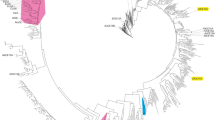Abstract
Arylsulfate sulfotransferase (ASST) transfers a sulfate group from a phenolic sulfate ester to a phenolic acceptor substrate. In the present study, the gene encoding ASST was cloned from a genomic library copy ofCitrobacter freundii, subcloned into the vector pGEM3Zf(-) and sequenced. Sequencing revealed two contiguous open reading frames (ORF1 and ORF2) on the same strand and based on amino acid sequence homology, they were designated asastA anddsbA, respectively. The amino acid sequence ofastA deduced fromC. freundii was highly similar to that of theSalmonella typhimurium, Enterobacter amnigenus, Klebsiella, Pseudomonas putida, andCampylobacter jejuni, encoded by theastA genes. However, the ASST activity assay revealed different acceptor specificities. Usingp-nitrophenyl sulfate (PNS) as a donor substrate, α-naphthol was found to be the best acceptor substrate, followed by phenol, resorcinol,p-acetaminophen, tyramine and tyrosine.
Similar content being viewed by others
References
Altschul, S. F., Gish, W., Miller, W., Myers, E. W., and Lipman, D. J., Basic local alignment search tool.J. Mol. Biol., 215, 403–410 (1990).
Baek, M. C., Kim, S. K., Kim, D. H., Kim, B. K., and Choi, E. C., Cloning and sequencing of theKlebsiella K-36astA gene, encoding an arylsulfate sulfotransferase.Microbiol. Immunol., 40, 531–537 (1996).
Baek, M. C., Kwon, A. R., Chung, Y. J., Kim, B. K., and Choi, E. C., Distribution of bacteria with the arylsulfate sulfotransferase activity.Arch. Pharm. Res., 21, 475–477 (1998).
Bardwell, J. C., McGovern, K., Beckwith, J., Identification of a protein required for disulfide bond formationin vivo. Cell, 67, 581–589 (1991).
Birnboim, H. C., A rapid alkaline extraction method for the isolation of plasmid DNA.Methods Enzymol., 100, 243–255 (1983).
Dodgson, K. S., and Tudball, N., The metabolite of the sulfate group of potassium p-nitrophenyl[35S]sulfate.Biocbem. J., 74, 154–159 (1960).
Goldberg, S. L., Nanduri, V., Cino, P. M., and Patel, R., Purification, cloning and characterization of an arylsulfotransferase gene from the anaerobic bacteriumEubacterium rectale IIIH.J. Ind. Microbiol. 25, 305–309 (2000).
Harley, C. B., and Reynolds, R. P., Analysis ofE. coli promoter sequences.Nucleic Acids Res., 15, 2343–2361 (1987).
Holt, J. G., N. R. Krieg, P. H. A. Sneath, J. T. Staley and S. T. Williams.,In Bergey’s manual of determinative bacteriology, The Williams & Wilkins Co., Baltimore, Md., (9th eds.), (1994).
Kahnert, A., and Kertesz, M. A., Characterization of a sulfurregulated oxygenative alkylsulfatase fromPseudomonas putida S-313.J. Biol. Cbem., 275, 31661–31667 (2000).
Kang, J. W., Kwon, A. R., Kim, D. H., and Choi, E. C., Cloning and sequencing of theastA gene encoding arylsulfate sulfotransferase fromSalmonella typhimurium.Biol. Pharm. Bull., 24, 570–574 (2001).
Kim, D. H., Konishi, L., and Kobashi, K., Purification, characterization and reaction mechanism of novel arylsulfotransferase obtained from an anaerobic bacterium of human intestine.Biocbem. Biophys. Acta., 872, 33–41 (1986).
Kim, D. H., and Kobashi, K., The role of intestinal flora in metabolism of phenolic sulfate esters.Biocbem. Pharmacol., 35, 3507–3510 (1986).
Kim, D. H., and Kobashi, K., Kinetic studies on a novel sulfotransferase fromEubacterium A-44, a human intestinal bacterium.J. Biocbem., 109, 45–48 (1991).
Kim, D. H., Kim, H. S., and Kobashi, K., Purification and characterization of novel sulfotransferase obtained fromKlebsiella K-36, an intestinal bacterium of rat.J. Biochem., 112, 456–460 (1992).
Kim, D. H., Kim, H. S., Imamura, L., and Kobashi, K., Kinetic studies on a sulfotransferase fromKlebsiella K-36, a rat intestinal bacterium.Biol. Pharm. Bull., 17, 543–545 (1994).
Kobashi, K., and Kim, D. H., A novel sulfotransferase sulfates tyrosine-containing peptides and proteins.Biocbem. Biophys. Res. Commun., 140, 38–42 (1986).
Kwon, A. R., Oh, T. G., Kim, D. H., and Choi, E. C., Molecular cloning of the arylsulfate sulfotransferase gene and characterization of its product fromEnterobacter amnigenus AR-37.Protein Expression Purit, 17, 366–372 (1999).
Lee, N. S., Kim, B. T., Kim, D. H., and Kobashi, K., Purification and reaction mechanism of arylsulfate sulfotransferase fromHaemophilus K-12, a mouse intestinal bacterium.J. Biochem., 118, 796–801 (1995).
Muramatsu, R., Nukui, E., Sukesada, A., Misawa, S., Komatsu, Y., Okayama, T., Wada, K., Morikawa, T., Hayashi, H., and Kobashi, K., Enzymatic O-sulfation of tyrosine residues in hirudins by sulfotransferase fromEubacterium A-44.Eur. J. Biochem., 223, 243–248 (1994).
Roy, A. B.,In Sulfotransferases, Sulfation of Drugs and Related Compounds, Mulder, G. J., (Eds.), CRC Press, Boca Raton, FL., pp. 131–185 (1981).
Sanger, F., Nicklen, S., and Coulson, A. R., DNA sequencing with chain-terminating inhibitors.Proc. Natl. Acad. Sci. USA., 74, 5463–5467 (1977).
Sekura, R. D., and Jakoby, W. B., Phenol sulfotransferase.J. Biol. Chem., 254, 5658–5663 (1979).
Sekura, R. D., Duffel, M. W., and Jakoby, W. B., Arylsulfotransferase.Methods Enzymol., 77, 197–206 (1981).
Shine, J., and Dalgarno, L., The 3’-terminal sequence ofEscherichia coli 16S ribosomal RNA: complementarity to nonsense triplets and ribosome binding site. Proc. Natl. Acad. Sci. USA., 71, 1342–1346 (1974).
Spencer, B., Endogenous sulfate acceptors in rat liver.Biochem. J., 77, 294–304 (1960).
Thompson, J. D., Higgins, D. G., and Gibson, T. J., Clustal W.: Improving the sensitivity of progressive multiple sequence alignment through sequence weighting, positionspecific gap penalties and weight matrix choice.Nucleic Acids Res., 22, 4673–4680 (1994).
Yao, R., and Cuerry, P., Molecular cloning and site-specific mutagenesis of a gene involved in arylsulfatase production inCampylobacter jejuni.J. Bacteriol., 178, 3335–3338 (1996).
Author information
Authors and Affiliations
Corresponding author
Rights and permissions
About this article
Cite this article
Kang, JW., Jeong, YJ., Kwon, AR. et al. Cloning, sequence analysis, and characterization of theastA gene encoding an Arylsulfate sulfotransferase fromCitrobacter freundii . Arch Pharm Res 24, 316–322 (2001). https://doi.org/10.1007/BF02975099
Received:
Issue Date:
DOI: https://doi.org/10.1007/BF02975099




